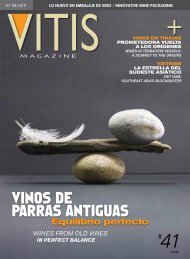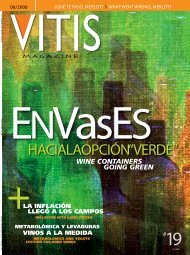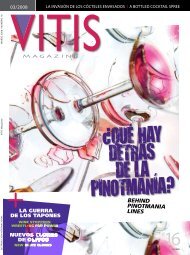Create successful ePaper yourself
Turn your PDF publications into a flip-book with our unique Google optimized e-Paper software.
e<br />
l pisco soUr, preparado y bebido en el perú,<br />
tiene un sabor único, distinto, insuperable. y no<br />
es sólo por el jugo de los norteños limones de<br />
chulucanas, perfumados y de acidez moderada,<br />
que armonizan de maravilla con el componente<br />
principal de este trago, el pisco peruano. este<br />
destilado, que poco a poco va encontrando su lugar en el mundo (hace<br />
algunas semanas, por primera vez las exportaciones peruanas de pisco sobrepasaron<br />
a las chilenas), tiene singulares características a las que bien<br />
vale la pena darles una mirada antes de juzgarlo precipitadamente desde<br />
una perspectiva nacionalista. además, su lugar de origen es uno de los<br />
estupendos atractivos turísticos que tienen nuestros vecinos del norte, y<br />
que todavía es un secreto bien guardado.<br />
pero partamos por el principio. ¿qué es el pisco para los peruanos?<br />
en palabras del director de la comisión peruana del pisco, Johnny<br />
schuler, “pisco es el producto obtenido de la destilación de mostos frescos,<br />
recientemente fermentados, de uvas pisqueras, elaborado en los valles costeños<br />
de los departamentos de lima, ica, arequipa y moquegua, y en los<br />
valles de samba, catrina y locumba del departamento de tacna”. su nombre<br />
dice relación con un vocablo de origen quechua, en uso desde hace<br />
miles de años, que no sólo tiene un significado bien específico –pajarillo o<br />
avecilla–, sino que también denomina una región, un río y hasta una cultura<br />
con siglos de existencia en la zona de donde proviene este destilado.<br />
estando allí, uno entiende claramente por qué nuestros vecinos defienden<br />
como propio el nombre de este destilado y su propiedad intelectual.<br />
es más, en la región de pisco habitaba un grupo de alfareros descen-<br />
on the perUvian<br />
pisco trail<br />
A quick glance at a map of Peru would suggest that<br />
the pisco growing area made up of the departments<br />
of Lima, Ica, Arequipa, Moquegua and Tacna is very<br />
widespread. In the practice, however, this is a wide<br />
expanse of mostly desert land, sprinkled with a few<br />
valleys especially apt for the production of pisco<br />
grapes. A visit to the city of Ica and some of its<br />
vineyards reveals why our northerly neighbors feel<br />
the name and intellectual property of this distillate as<br />
their own.<br />
Pisco sour PrePared in the Peruvian style has a unique,<br />
distinct, even unsurpassable flavor. This is partly the result<br />
of using the fragrant and moderately acidic juice of lemons<br />
grown in chulucanas, a perfect match for the main<br />
ingredient of this drink: Peruvian pisco. Little by little, this<br />
beverage has found a place of its own in the international<br />
marketplace. in fact, a few weeks ago and for the first time<br />
ever, Peruvian pisco exports outnumbered chilean ones. The<br />
distillate offers singular characteristics worth investigating<br />
from a neutral, non-nationalistic perspective. also, its place<br />
of origin is one of the country’s great tourist attractions and a<br />
well-kept secret.<br />
Let us start at the beginning: What does pisco represent<br />
for the Peruvian people?<br />
Quoting the director of the Peruvian Pisco commission,<br />
Johnny schuler, “pisco is the product of the distillation or<br />
fresh, recently fermented must of pisco grapes, made in the<br />
coastal valleys of the departments of Lima, ica, arequipa,<br />
and Moquegua, and in the valleys of samba, catrina and<br />
Locumba located in the department of Tacna. The name<br />
seems to stem from an ancient quechua word meaning<br />
specifically “little bird” that also refers to a region, a river<br />
and even a centuries-old culture that developed in the<br />
area where this distillate originated. a visit to the region<br />
helps understand why our northerly neighbors defend the<br />
distillate’s name and intellectual property as their own.<br />
Moreover, the region of Pisco was the homeland of a<br />
group of potters descending from the Paraca culture – called<br />
Pishcos – who produced lovely amphoras that somehow<br />
reminisce Greek earthen vessels. These same containers<br />
were later on used to keep the product obtained from the<br />
distillation of grapes, pisco, so the name came to designate<br />
▼ <strong>Vitis</strong> <strong>Magazine</strong> l novieMbre 2008 l 49






